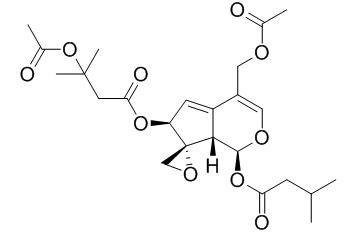Acevaltrate
Acevaltrate displays high cytotoxicity against GLC(4), a human small-cell lung cancer cell line, and against COLO 320, a human colorectal cancer cell line, with IC50 values of 1-6 uM. Acevaltrate inhibits the Na+/K+-ATPase activity in the rat kidney and brain hemispheres with IC50s of 22.8±1.1 μM and 42.3±1.0 μM, respectively.
Inquire / Order:
manager@chemfaces.com
Technical Inquiries:
service@chemfaces.com
Tel:
+86-27-84237783
Fax:
+86-27-84254680
Address:
1 Building, No. 83, CheCheng Rd., Wuhan Economic and Technological Development Zone, Wuhan, Hubei 430056, PRC
Providing storage is as stated on the product vial and the vial is kept tightly sealed, the product can be stored for up to
24 months(2-8C).
Wherever possible, you should prepare and use solutions on the same day. However, if you need to make up stock solutions in advance, we recommend that you store the solution as aliquots in tightly sealed vials at -20C. Generally, these will be useable for up to two weeks. Before use, and prior to opening the vial we recommend that you allow your product to equilibrate to room temperature for at least 1 hour.
Need more advice on solubility, usage and handling? Please email to: service@chemfaces.com
The packaging of the product may have turned upside down during transportation, resulting in the natural compounds adhering to the neck or cap of the vial. take the vial out of its packaging and gently shake to let the compounds fall to the bottom of the vial. for liquid products, centrifuge at 200-500 RPM to gather the liquid at the bottom of the vial. try to avoid loss or contamination during handling.
Mol Immunol. 2016, 78:121-132
Journal of Functional Foods2022, 91:105019.
Institute of Food Science & Technology2021, 18 December.
Nutrients.2020, 12(5):1242.
J Cell Mol Med.2023, 27(11):1592-1602.
Mol Microbiol.2019, 112(1):317-332
Indian J. of Experimental Bio.2020, 9(58).
VNU Journal of Science2023, 39(2):24-33.
J Nat Prod.2022, doi: 10.1021
Pharm Biomed Res2023, 9(3):173-182.
Related and Featured Products
Planta Med. 2011 Oct;77(15):1702-6.
In vitro effect of valepotriates isolated from Valeriana glechomifolia on rat P-type ATPases.[Pubmed:
21567360 ]
Valepotriates are iridoids found in variable amounts in Valerianaceae and might be among the bioactive compounds which confer anxiolytic properties to the Valeriana species. On the other hand, unspecific cytotoxicity has also been described. Presently, however, no particular molecular target has been defined for these compounds.
METHODS AND RESULTS:
Here we studied the effect of valtrate, Acevaltrate, and 1- β-Acevaltrate isolated from Valeriana glechomifolia on the enzymatic activity of rat P-type ATPases. Valepotriates did not affect rat skeletal muscle sarco/endoplasmic reticulum Ca2⁺-ATPase (SERCA) activity at the highest concentration used (100 μM). In contrast, the same concentration inhibited roughly half of the total H⁺/K⁺-ATPase activity from rat gastric epithelium (valtrate 54.6 ± 3.2 %, Acevaltrate 60.7 ± 7.3 %, 1- β-Acevaltrate 50.2 ± 3.1 %; mean ± SEM, n = 3-5). Finally, these substances showed the highest inhibitory potency toward Na⁺/K⁺-ATPase, and the inhibition curves obtained provided a similar IC₅₀ (in μM) for rat kidney α1 isoform (valtrate 21.2, Acevaltrate 22.8, 1- β-Acevaltrate 24.4) and brain hemispheres α2/ α3 isoforms (valtrate 19.4, Acevaltrate 42.3, 1- β-Acevaltrate 38.3).
CONCLUSIONS:
Our results suggest that P-type ATPases are differentially inhibited by valepotriates and that Na⁺/K⁺-ATPase might be one of their molecular targets in vivo.
Phytomedicine. 1998 May;5(3):219-25.
Cytotoxic potential of valerian constituents and valerian tinctures.[Pubmed:
23195845 ]
Underground parts of three Valeriana species, namely V. officinalis L. s.l., V. wallichii DC. (V. jatamansi Jones), and V. edulis Nutt. ex Torr & Gray ssp. procera (H.B.K.) F. G. Meyer (V. mexicana DC.), are used in phytotherapy because of their mild sedative properties.
METHODS AND RESULTS:
Characteristic constituents of these species, which are regarded also as the active principles, were tested for cytotoxicity against GLC(4), a human small-cell lung cancer cell line, and against COLO 320, a human colorectal cancer cell line, using the microculture tetrazolium (MTT) assay. Valepotriates of the diene type (valtrate, isovaltrate and Acevaltrate) displayed the highest cytotoxicity, with IC50 values of 1-6 μM, following continuous incubation.
CONCLUSIONS:
The monoene type valepotriates (didrovaltrate and isovaleroxyhydroxydidrovaltrate) were 2- to 3-fold less toxic. Baldrinal and homobaldrinal, decomposition products of valepotriates, were 10- to 30-fold less toxic than their parent compounds. Isovaltral had a higher cytotoxicity than its parent compound isovaltrate.



